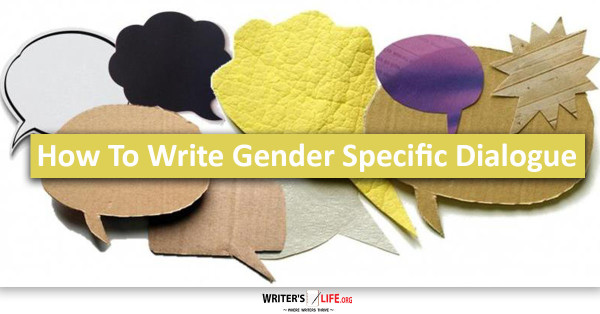- How To Tackle Jealousy In Creative Writing
- Common Submission Mistakes
- How To Stop Your Blog Becoming Boring
- The One Thing Every Successful Writer Has In Common
- How To Make Yourself Aware Of Publishing Scams
- Why Almost ALL Writers Make These Grammar Mistakes At Some Point
- 5 Tips For Authors On How To Deal With Rejection
- Top Mistakes to Avoid When Writing a Novel
- How to Avoid Common New Writer Mistakes
- 10 Mistakes New Fiction Writers Make
Writing Gender Specific Dialogue

Writing realistic and engaging dialogue is one of the aspects of writing a novel that many writers struggle with. You want to write a conversation that is believable, but at the same time, if you tried to write exactly as human beings actually speak, your dialogue would be slow, clumsy, and hard to follow.
Writing gender specific dialogue adds another dimension of difficulty to your writing. Particularly if you are trying to write dialogue for a character whose gender is not your own!
Most novels will usually have a whole cast of characters both male and female. So trying to get the differences in speech right, as well as the language used, and simultaneously conveying the tone of voice effectively requires a great degree of skill.
You need to be able to do this without spelling it out for the reader - remember the old 'show don’t tell rule'? Well it applies to dialogue too.
So how do you write gender specific dialogue? Here are some tips to help you.
Let’s start with the guys!
Questions and explanations
Men tend to ask more direct questions. They want information, and they want it delivered to them without fuss or frills.
If you hero asks a question make sure it is not rhetorical, or that it can’t be answered in a straightforward manner.
Check your hero’s responses too. Men tend to be specific and short with their responses when asked to volunteer information, and don’t always try to justify what they do.
Details
Generally men pay less attention to the details of things, so when they are describing something, try not to make their explanations overly detailed or flowery.
Scale back their level of detail. This doesn’t mean they can’t be observant, particularly when they need to be, but try to stick to the basics and don’t let the language become unnecessarily descriptive when it doesn’t need to be.
Emotions
As a rule, men tend to speak less emotively than women. If your male character is being very expressive and emotional, ask yourself if it is right for the scene. They tend to use less metaphors and euphemisms too.
Men also tend to care less about other people’s opinions of what they say. If your male character is constantly seeking approval and validation, try to reign this in and make their speech less effected by what other characters might think.
For the gals!
Advice
Women tend to give a lot more advice when they talk. They offer their opinion. They think about what the other person has said, carefully consider it, and then react.
Agression
Women tend to be more passive aggressive than direct. If your female character is feeling angry think carefully about what she would say, would she immediately get angry or would she be more manipulative and cunning in her response?
Details
Women are more likely to notice the details of places, people and the things around them. When they speak therefore, they are more likely to include specific details in their dialogue.
Emotion and persuasion
Women talk more persuasively and emotively than men. They are more likely to use euphemisms and metaphors too. Using phrases such as 'I think' 'and 'I feel' will help your female character's dialogue convey more emotions.
Of course, what we must remember is that these are all generalisations, and there are exceptions to every rule.
Breaking the stereotypes, if you can do it well, can lead to a very interesting and engaging character indeed.
However, the most important point is to stay true to your characters - only you know what kind of person you are trying to convey, and, as long as you are consistent then the dialogue should come across as realistic anyway.
Listening to real life conversations is an excellent way of learning more about how actual people talk to one another! Sit on a bus for the day and make notes of all the different conversations that you hear.
Reading your dialogue out loud will also help you check to see if it feels realistic. It is easy to skim read what you have written and not notice the awkward lines in your dialogue - reading aloud will make sure you don’t miss anything and that your character’s conversations flow!
Gender specific dialogue is a tough thing to get right, but by using these tips and continuing to practice, you can improve and refine your dialogue to make it realistic and engaging for your readers.






























